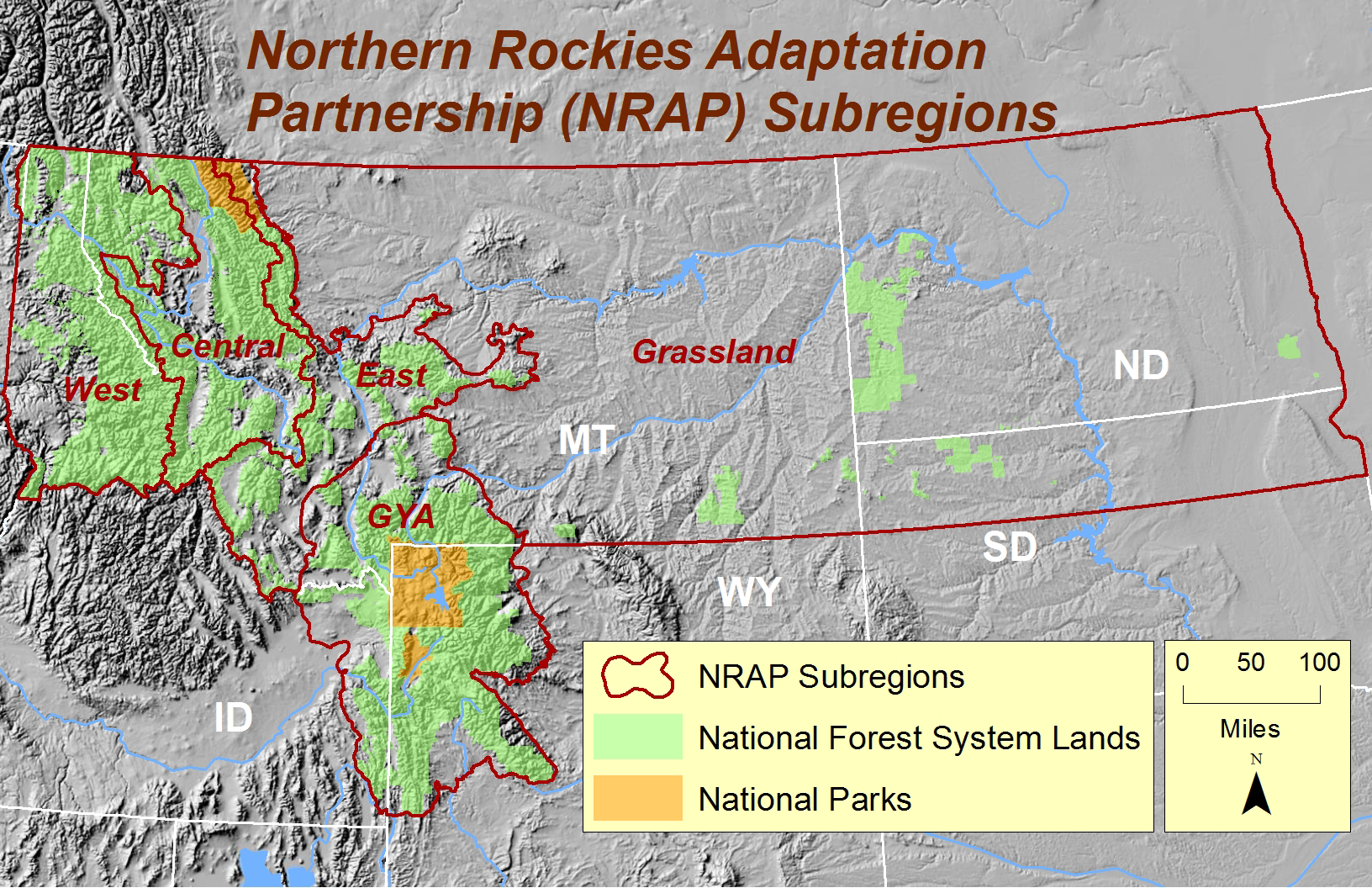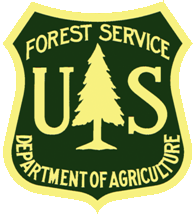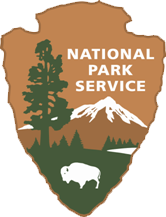
NRAP is a science-management collaboration with the goals of:
- Assessing vulnerability of natural resources and ecosystem services to climate change; and
- Developing science-based adaptation strategies that can be used by national forests to understand and mitigate the negative effects of climate change.
NRAP News
-
2018: Our General Technical Report (GTR) is available (Part 1 | Part 2)
Halofsky, Jessica E.; Peterson, David L.; Dante-Wood, S. Karen; Hoang, Linh; Ho, Joanne J.; Joyce, Linda A., eds. 2018. Climate change vulnerability and adaptation in the Northern Rocky Mountains. Gen. Tech. Rep. RMRS-GTR-374. Fort Collins, CO: U.S. Department of Agriculture, Forest Service, Rocky Mountain Research Station.
p. 1-273. doi:10.2737/RMRS-GTR-374PART1.
p. 275-475. doi:10.2737/RMRS-GTR-374PART2. -
10/2014: Federal land managers draft plan confronting climate change. Missoulian (Subscription required)
-
NRAP Newsletters
June 2014 | July 2014 | Oct 2014 | Nov 2014 | February 2015
Project Overview
Objectives
- Develop a framework and tools for resource managers to incorporate the best available science into landscape/planning assessments, resource management and planning, resource monitoring, project design, NEPA analysis, conservation strategies, and State Wildlife Action Plan updates.
- Synthesize the best available scientific information to assess climate change vulnerability and develop adaption options throughout the U.S. Northern Rocky Mountains ecoregion in order to understand and mitigate potentially adverse effects of climate change on natural resources and ecosystem services.
Target Outcomes
- The vulnerability assessment will provide information on climate change effects needed for national forest plans, project plans, conservation strategies, and restoration. The assessment will be particularly usefulfor national forest and park planning and management.
- Climate change sensitivities and adaptation options developed at the regional scale will provide the scientific foundation for sub-regional and national forest and park vulnerability assessments, adaptation planning, and resource monitoring.
- Training will be provided to resource specialists who, in conjunction with place-based information, can apply climate change to land management throughout the region.
- Climate change will be operationalized throughout the region resource management and planning.
Focus Area
The Northern Rockies region includes 15 national forests, nearly 20 wilderness areas, and 3 national parks across the U.S. Forest Service Northern Region and the adjacent Greater Yellowstone Area. The area spans northern Idaho, Montana, northwest Wyoming, North Dakota, and northern South Dakota.
The Vulnerability and Adaptation project addresses 5 subregions:
- Western Rockies: Idaho Panhandle NF, Kootenai NF, Nez Perce-Clearwater NF, Glacier NP
- Eastern Rockies: Beaverhead-Deerlodge NF (eastern portion), Custer NF (eastern portion), Gallatin NF (northern portion), Helena NF, Lewis and Clark NF
- Central Montana: Bitterroot NF, Flathead NF, Lolo NF
- Grasslands: Custer NF (part), Dakota Prairie NG
- Greater Yellowstone Area: Bridger-Teton NF, Caribou-Targhee NF, Shoshone NF, Gallatin NF (southern portion), Custer NF (western portion), Beaverhead-Deerlodge NF (western portion), Grand Teton NP, Yellowstone NP
Climatological gradients contribute to the ecological diversity found within the region. The western portion of the area is influenced by the warm and wet maritime airflows from the Pacific Ocean. In contrast, the eastern portion of the region is dominated by cooler and drier airflows from Canada. As a result, annual precipitation can be upward of 200 cm in northern Idaho and as low as 20 cm in central and eastern Montana.
These broad climatological differences, together with local geologic variation, form the basis of ecological diversity. In the western portion of the region, coniferous forests dominate; common species include ponderosa pine, Douglas-fir, grand fir, western redcedar, western hemlock, lodgepole pine, subalpine fir, Engelmann spruce, and whitebark pine. At the extremes, ponderosa pine is typically in low elevation, warm and dry locations, whereas whitebark pine, subalpine fir, and Engelmann spruce are in cold, high elevation locations. Moving eastward into drier areas across Montana and into the Greater Yellowstone Area, ponderosa pine, Douglas-fir, and lodgepole pine are more common. In eastern Montana and the Dakotas, the region’s driest area, the occasional ponderosa pine stand transitions to bur oak and prairie grasslands.
In addition to ecological diversity, hydrology, fisheries, wildlife, and recreation are important resource values for the region. In the western portion of the region, steep mountains streams, including the headwaters to the Snake-Columbia, Colorado-Green, and Missouri-Mississippi, support diverse fisheries. To the east, wetlands are prevalent and contribute to fish and avian diversity. Utilizing aquatic and terrestrial habitats, the region’s wildlife includes black bear, grizzly bear, bobcat, Canada lynx, mountain lion, coyote, gray wolf, red fox, swift fox, bison, bighorn sheep, mountain goat, elk, mink, black-footed ferret, fisher, and wolverine.
The socio-economic foundation of the region is based on these natural resources. The geographic and ecological diversity of the region, especially on national forest and national park land, contribute to a robust recreational industry. Population centers are distributed around resource-based activities, including timber, agriculture, grazing, and energy production. These economic and natural resources inform management decisions throughout the region.
Approach & Timeline
Approach
- Develop a science-management partnership comprised of key personnel from throughout the region, national forests, national parks, Forest Service research stations, and other organizations.
- Write a draft climate change vulnerability assessment that addresses the following priority resource areas in Region 1: hydrology and roads, fisheries, wildlife, vegetation and disturbance, recreation, and socioeconomic conditions.
- Convene a workshop for the science-management partnership and other participants to identify the most significant vulnerabilities to climate change throughout the region, and develop specific adaptation strategies and tactics.
- Develop guidance for the implementation of adaptation strategies and tactics at various management operation levels (project design, resource program, and forest planning).
- Compile all information in a report, conduct peer review, and publish the report.
Tentative timeline
- October 2013: September 2014: Compile information for vulnerability assessment
- October 2014: Convene workshops for science-management partnership in Missoula and Coeur d’Alene; review vulnerability assessment and development adaptation options
- November 2014: Convene workshops for science-management partnership in Bozeman and Bismarck; review vulnerability assessment and development adaptation options
- November 2014 – December 2015: Complete final report, review, and submit for publication
Partners & Funding
Partners
NRAP partners include:
as well as the Greater Yellowstone Coordinating Committee.
Funding
This project is supported in part by funding from the National Oceanic and Atmospheric Administration to the Pacific Northwest Climate Impacts Research Consortium and Oregon State University.






